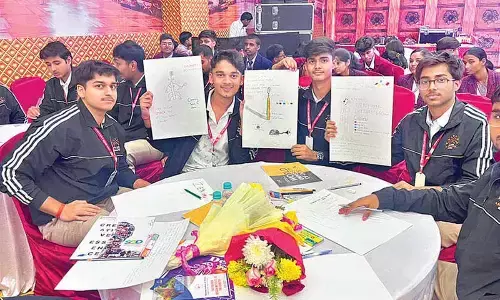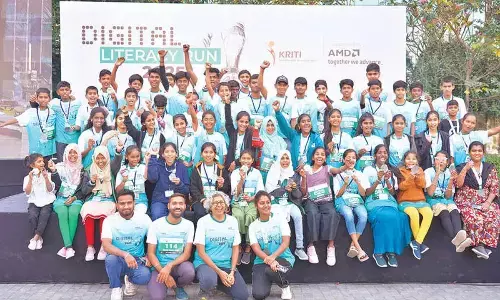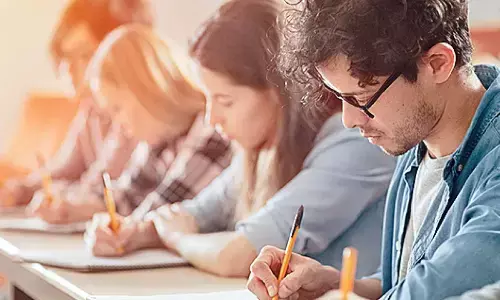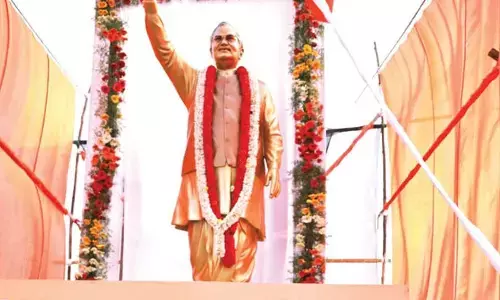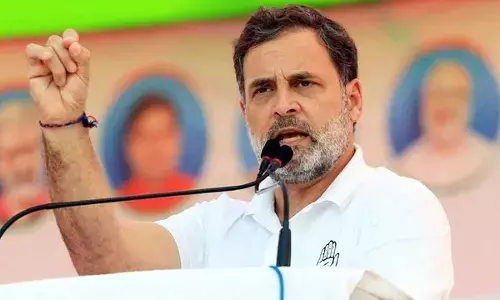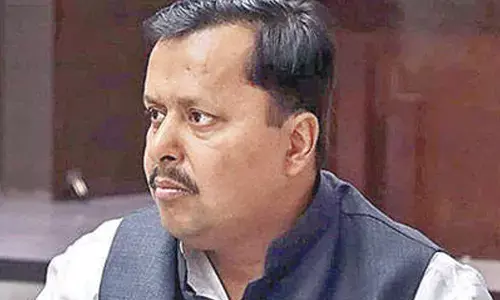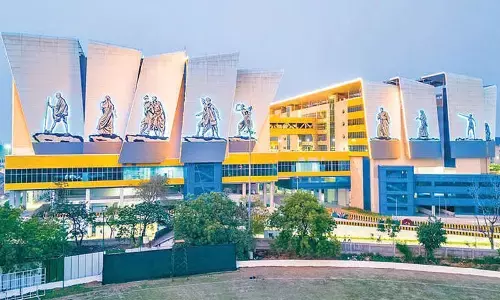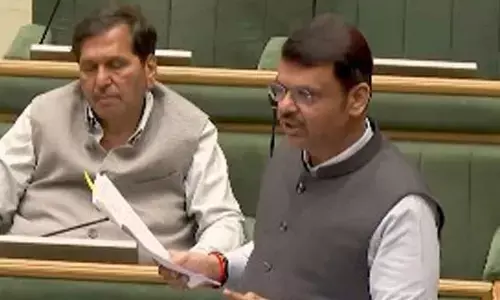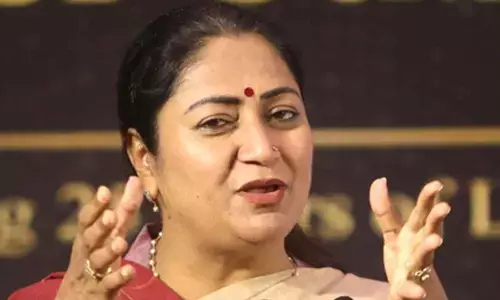Will UP send Modi to Delhi?

Will UP Send Narendra Modi to Delhi. It has been long said that the road to Raisina Hill goes via Lucknow. Till 1984 elections, UP had pride of place since the Congress PM candidates were getting elected in UP and the party used to get maximum number of seats from that State. The decline in the Congress’ fortunes in UP changed the route to Delhi.
Muzaffarnagar riots helped the BJP and harmed the SP. The only eventuality that could stop the Modi juggernaut is a tie-up between the BSP and the Congress
Most opinion polls so far predicted 40-45 seats for the BJP in UP. Varanasi is expected to work as a springboard to influence eastern UP, adjoining areas in Bihar
Nearly 20% of the UP voters are Muslims. If this vote is divided three ways between the SP, Cong, BSP, the BJP candidates can squeak through with about 30% of votes
If Muslims decide en bloc to punish the SP and vote for BSP-Congress combination to defeat the saffron party, that would certainly be a setback for the Modi project
It has been long said that the road to Raisina Hill goes via Lucknow. Till 1984 elections, UP had pride of place since the Congress PM candidates were getting elected in UP and the party used to get maximum number of seats from that State. The decline in the Congress’ fortunes in UP changed the route to Delhi.
When BJP won 51 Lok Sabha seats out of 85 in UP (Uttarakhand was part of UP) in 1998 and went on to form the government with Atal Behari Vajpayee as PM, UP claimed back its rightful place. But with the ascendency of Samajwadi Party (SP) and Bahujan Samaj Party (BSP) and none of them being at the helm of any coalition arrangement, UP had lost its importance in the national context.

In 2009, the Congress had to reach Delhi via Hyderabad which gave the grand old party as many as 33 LS seats. After a lengthy eclipse, UP has bounced back as a key battlefield State. Thanks again to the BJP. Narendra Modi has to register a phenomenal win in this State for his party to realize his ambition of being the next PM.
If it happens, the road to Delhi would go through Varanasi where Modi is set to be a candidate.
WILL HAVE TO DO BETTER THAN THE BEST
Most opinion polls so far predicted 40-45 seats for the BJP in UP. Varanasi is expected to work as a springboard to influence eastern UP and adjoining areas in Bihar. With the Congress party careening down the slippery slope, the ruling SP has been facing all kinds of incumbency related problems and the main Opposition party, BSP, is showing no upward trend in its popularity, the BJP’s stock has been steadily going up.
Muzaffarnagar riots helped the BJP and harmed the SP. The only eventuality that could stop the Modi juggernaut is a tie-up between the BSP and the Congress. This combine is sure to be sponsored by the Muslims who are disillusioned with Mulayam Singh Yadav and his chief minister son Akhilesh Yadav.
Nearly 20 per cent of the UP voters are Muslims and they are in a position to influence the outcome of the results in at least 40 Lok Sabha constituencies. If this vote is divided three ways between the SP, Congress and BSP, the BJP candidates can squeak through with about 30 percent of votes. But if the Muslims decide en bloc to punish the SP and vote for BSP-Congress combination to defeat the saffron party, that would certainly be a setback for the Modi project.
Both the BSP and the Congress have fielded Brahmin candidates in large numbers in order to prevent that community from going back to the BJP. The Brahmin leaders in the BJP also feel slighted at their constituencies being shifted- Lalji Tandon, a protégé of Vajpayee, was forced to yield Lucknow for party president Rajnath Singh.
Dalit-Muslim-Brahmin power bloc, if it comes about, would be formidable and may mean a lot of trouble for Modi. There are some 50 constituencies where Dalits and Muslims together make more than 40 percent of the electorate. It would remind us of the Indira Gandhi’s winning social alliance with which she fought back the Jat-OBC combine headed by Chaudhary Charan Singh in 1970s.
Though ‘Maulana’ Mulayam has fallen from his pedestal in the wake of Muzaffarnagar riots, Mayawati does not command undiluted respect of the Muslims either. She formed three governments earlier with the help of the BJP. If senior journalist MJ Akbar’s joining the BJP would have a positive bearing on the Muslim psyche and make the community less apprehensive of the BJP, the intensity of desire to defeat Modi by strategic voting may come down.
If the slogans like ‘Har Har Modi’ persist even after the order by the Chief Election Commissioner, the emotional quotient would go up endangering the BJP. Mayawati may have different ideas. She would perhaps like to put up candidates in all the constituencies without sharing with the Congress. But the latter would have its value as a secular party and may be useful in attracting the Muslim votes in bulk.
MEDIA HYPE
The hype created by the media and the BJP network around Modi has deflected attention from the poor state of the party organisation. It’s social base got eroded as was evident in recent elections. In late 1980s, communal polarisation on Mandir-Masjid issue created a massive Hindu vote bank in UP.
This was responsible for rise of the BJP’s stock in UP from 7.58 percent vote share and 8 LS seats in 1989 to 32.82 percent vote and 51 seats in 1991.
The fall of Babri Masjid marked the steep decline in the popularity of the BJP in UP. After the hate symbol was demolished, the BJP could not whip up emotions any longer and had to yield ground to the regional parties. While it won a whopping 51 seats in 1996, they were almost halved in the next election and reduced to 10 in 2004 and 2009.
The no-holds-barred campaign unleashed by Modi’s supporters is aimed at taking the temperatures to the peak. A new set of young leaders who are fiercely loyal to Modi have been propelling the campaign. Between 1996 when the BJP bagged the highest number of seats from UP and now, the BJP’s strength has come down. Its tally is half of the Congress in 2009 although it is no reflection of the actual strength of the Congress or weakness of the BJP.
The RSS and Viswa Hindu Parishad have strong presence in UP and both are actively supporting the BJP this time. The Congress is in a bad shape. But both the SP and the BSP are strong and they have faster reflexes. Modi has concentrated on UP since he knows it is the main battlefield and the mantle has to be won there. The highly calibrated campaign he mounted appears to have gone down well with the common people who are chanting NaMo mantra. A group of 200 young men and women is slated to manage the BJP war room in Varanasi.
Though Modi has been maintaining restraint not allowing religious overtones in the campaign outside UP, he has deliberately encouraged the party and its front organizations to take advantage of the communal divide in the state. The very fact that Modi chose Varanasi, a symbol of Hinduism and an ancient temple town, as his constituency makes the intentions of the BJP leadership clear.
The party does not mind if the workers talk about building Ram temple or abolishing Article 370 of the Constitution or enforcing Common Civil Code. Top leaders won’t be referring to these issues but the atmosphere would be surcharged with religious emotions. A number of senior politicians are positioned in different areas to inspire the cadres. Kalyan Singh is in charge of the campaign in Braj area which has 8 LS seats. OBCs and Upper Castes dominate this region. Bundelkhand is under Uma Bharati’s watch. The former Chief Minister of Madhya Pradesh has been canvassing in the region for many weeks now. This OBCs dominated area has 4 LS seats. Lakshmikant Bajpai, UP State president of BJP, is taking care of the Jats and Gujjars dominated area of Western UP which has 14 seats.
Bareilly zone that has many Gandhis in fray is kept in charge of Maneka Gandhi. Kurmis and Brahmins are in a deciding position in the zone where Sanjay Gandhi’s wife is a candidate.
Kanpur zone which has 6 seats is dominated by Brahmins and Murali Manohar Joshi who was shifted from Varanasi is the tallest leader contesting from this area.
Gorakhpur region has 13 seats. It is influenced by Kurmis and Thakurs. Gorakhpur MP Yogi Adityanath is the most popular person in this region.
OBCs and Upper Castes have sway over Avadh region which has 16 LS seats. BJP national president Rajnath Singh himself is contesting from Lucknow. The eastern UP has 14 seats including Modi’s Varanasi. The presence of the prime ministerial candidate must create a wave in favour of the BJP in this region.
It would not suffice even if the BJP improves its 2009 tally by four times. It has to do far better. It needs at least 50 seats from UP if it has to get more than 200 seats on its own strength. Which means the SP, the BSP and the Congress will have to lose very badly. Though Modi wave is quite visible, it would not be enough to get a windfall. It has to be a storm. UP is not Gujarat. UP has entrenched and resourceful regional parties.









